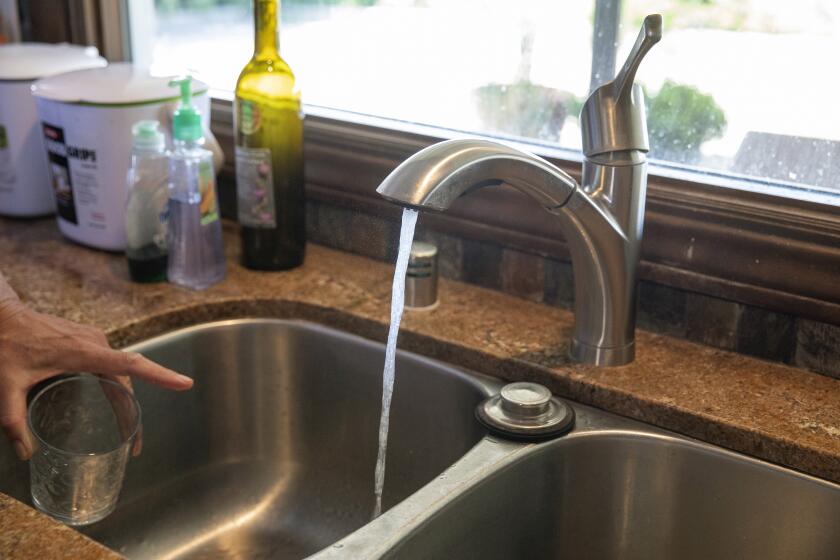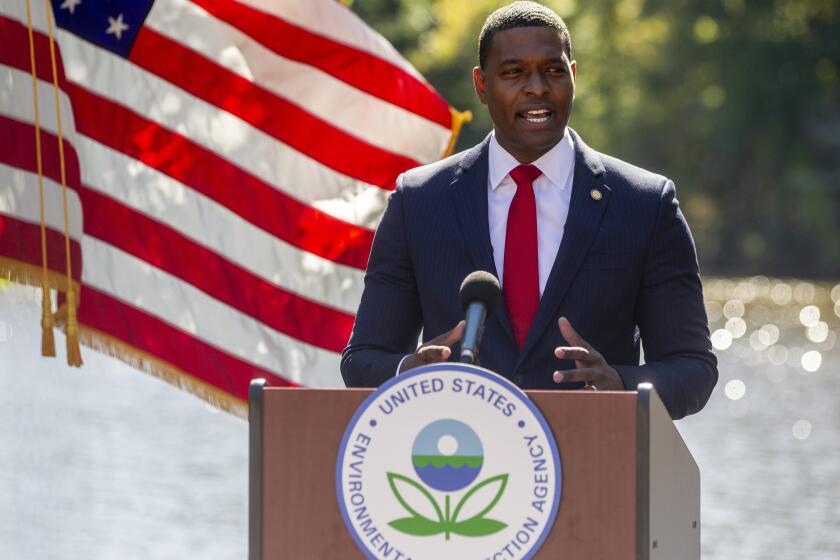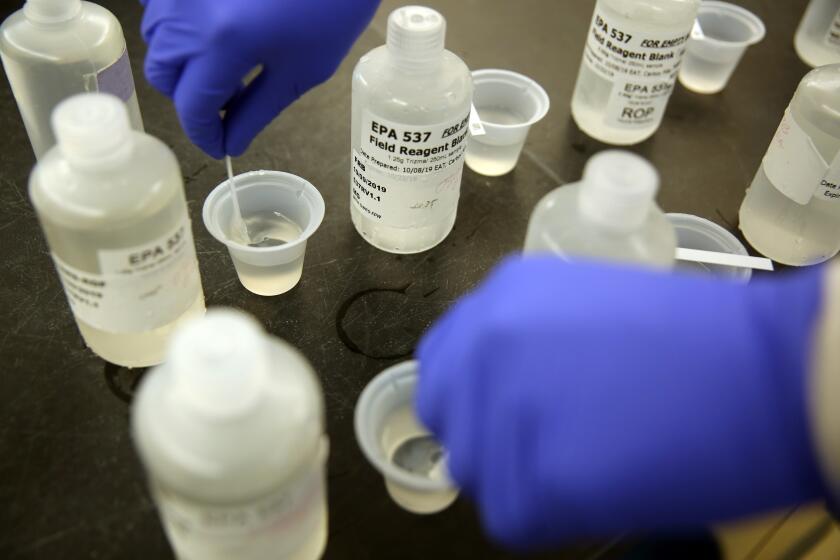‘This is taking too long’: California community awaits cleanup of PFAS-contaminated wells
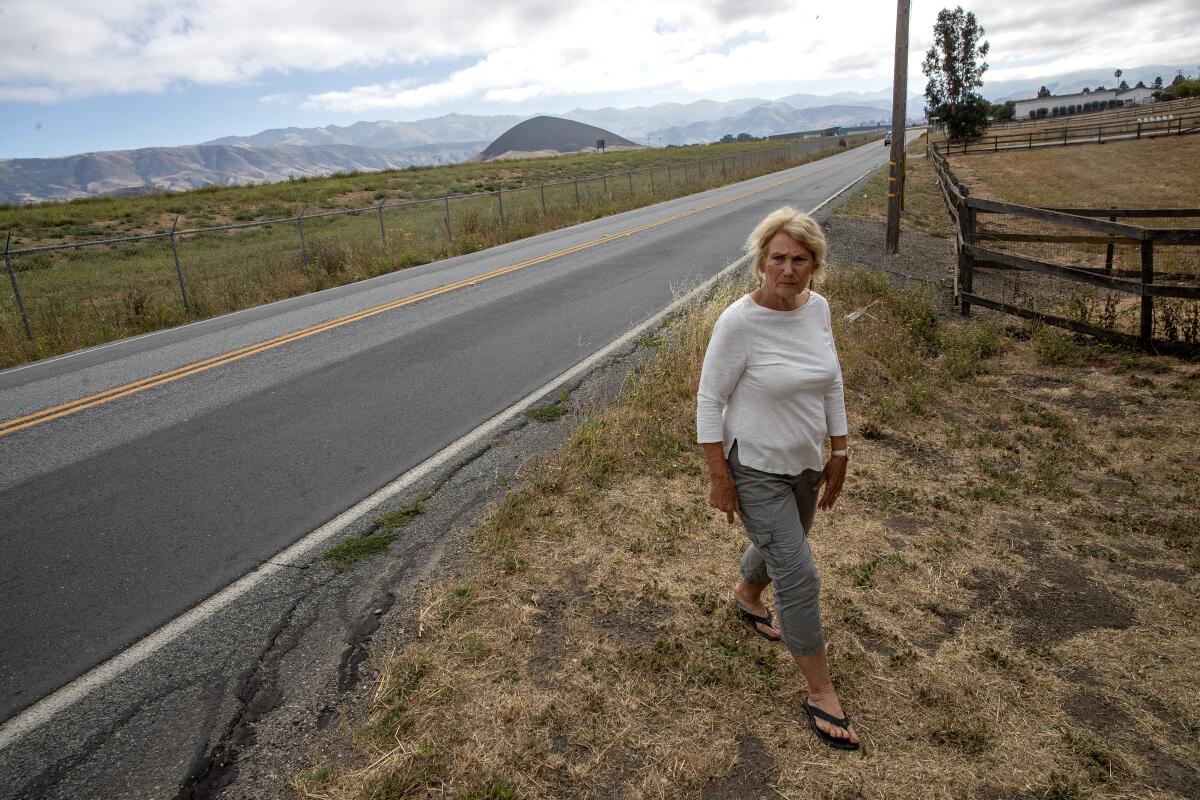
- Share via
SAN LUIS OBISPO — Kathy Borland has lived for four decades in a house beside the San Luis Obispo County Regional Airport, raising seven children and using water from the family’s well to water the garden, cook and drink.
Over the years, she sometimes noticed fire trucks stopped on the tarmac, but she never thought much about it. In June of last year, she was notified that her well was contaminated with high levels of harmful PFAS chemicals from the firefighting foam used during drills. Dozens of her neighbors were also warned of chemicals in their water.
“We don’t really know how long this contamination has been going on,” Borland said. “It could have taken 20 years to seep into our groundwater.”
At least 45% of the nation’s tap water is estimated to have PFAS ‘forever chemicals,’ with urban residents more likely to be exposed, new research says.
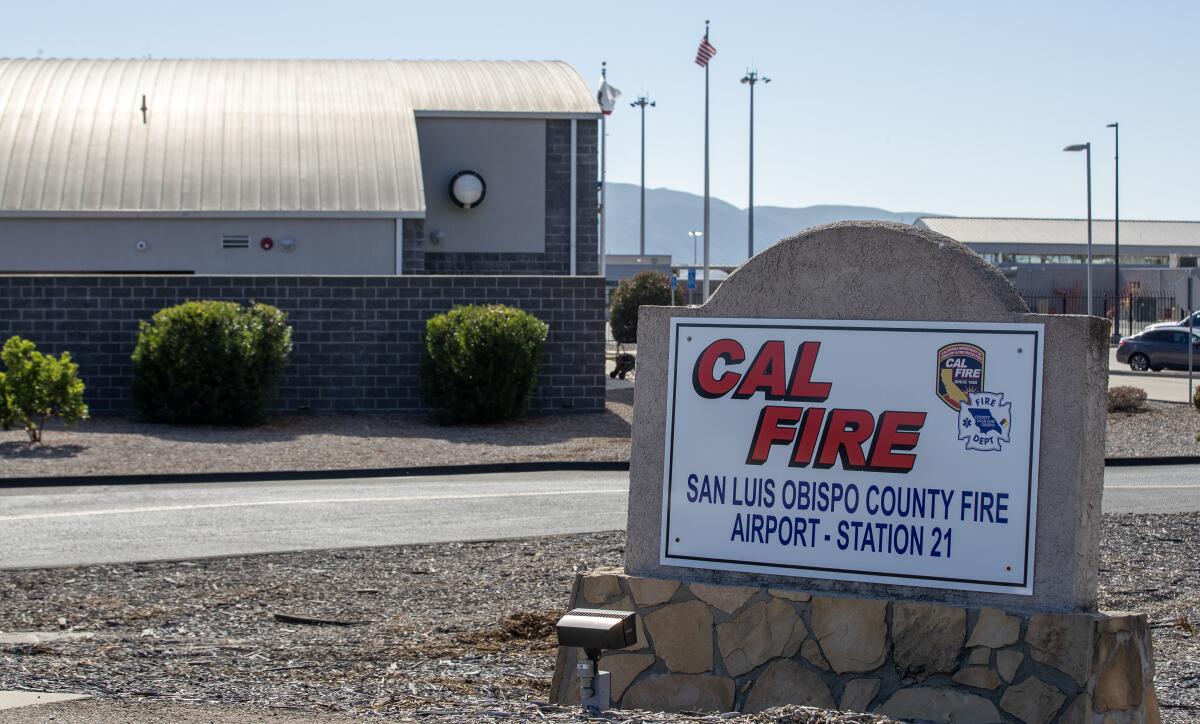
In July, state water regulators approved an agreement for San Luis Obispo County and the California Department of Forestry and Fire Protection to clean up the contamination, starting with the installation of household filters. The agreement, endorsed by the Central Coast Regional Water Quality Board, is the first of its kind in the state, and similar cleanup efforts could follow at other airports where the use of firefighting foam has left groundwater polluted.
Borland said she and her neighbors hope to see officials move quickly to install treatment systems at each well.
“Right now, they just need to give us safe water,” said Borland, a 76-year-old retired nurse and community leader. “This is taking way too long.”
PFAS, or per- and polyfluorinated substances, are a group of chemicals that have been widely used for decades to make coatings and products that resist heat, oil and water. They’ve been used in food packaging, insulation for electrical wire, nonstick pans and water-repellent clothing, along with firefighting foam.

Known as “forever chemicals” because they don’t naturally break down in the environment, PFAS chemicals have made their way into rivers, lakes and aquifers, as well as people’s blood.
The Environmental Protection Agency plans to begin regulating several types of PFAS chemicals in drinking water and has proposed a strict limit of 4 parts per trillion for the chemicals perfluorooctanoic acid (PFOA) and perfluorooctane sulfonic acid (PFOS).
Research has shown links between high levels of some PFAS and health problems such as high cholesterol, high blood pressure, kidney cancer, testicular cancer, thyroid issues and damage to the liver and the immune system.
Borland said she and her neighbors wonder how the PFAS in their water might be affecting their health.
A decade ago, Borland suddenly developed cirrhosis of the liver. She recovered, but said neighbors have had illnesses including kidney disease, prostate cancer and ovarian cancer.
“It stays in the environment forever, apparently. And what does it do to our bodies? None of us really knows,” Borland said.
The Los Angeles Times reviewed hundreds of pages of Pentagon documents and found California has more bases contaminated with the chemicals, known as PFAS, than any other state — at least 21 that exceed federal health guidelines.
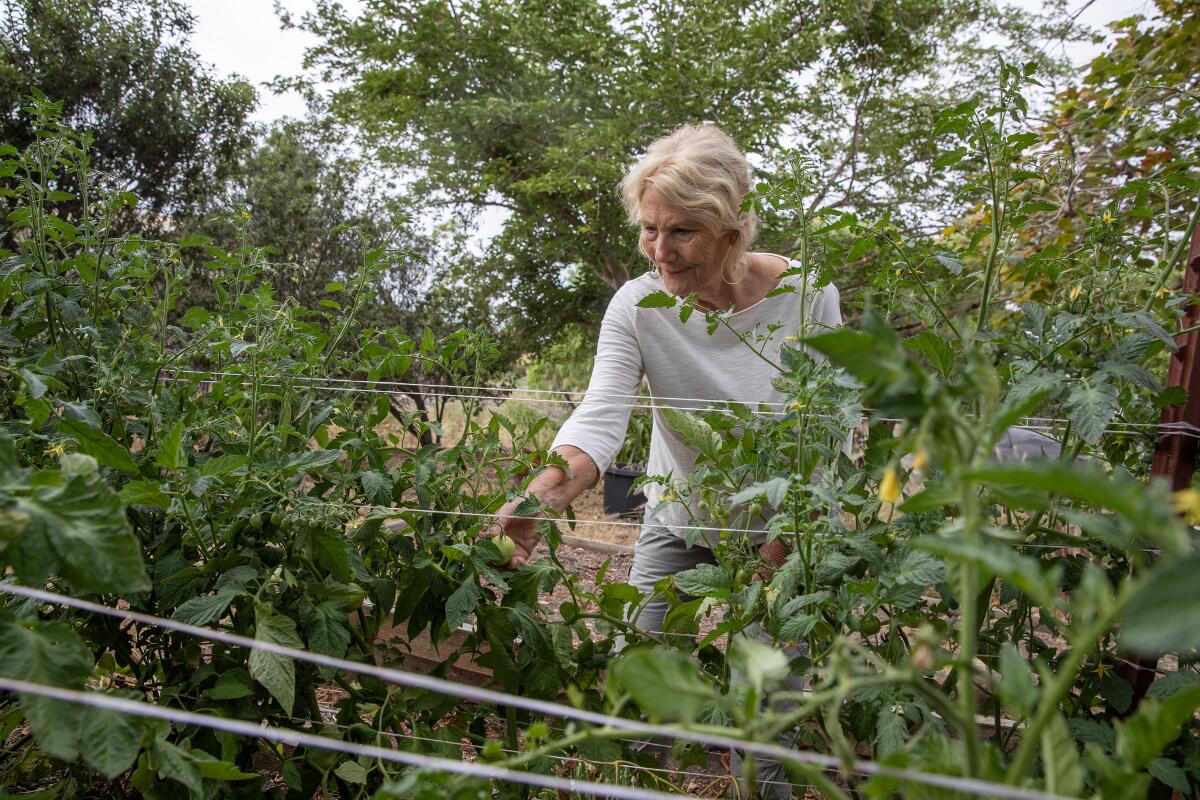
Borland is the co-founder of a community group called Preserve the SLO Life. She and her neighbors said they were pleased when the Water Quality Board approved the cleanup agreement, but they still want more testing and expedited efforts to address the problem. They also want the county to carry out a health survey, as state officials have recommended.
Borland and her husband, Jim, have lived in their house since they bought the 2-acre property in 1983. While their children were growing up, they raised goats, sheep and chickens.
They now use a filter that treats the water coming into their home. But they still water their yard with the contaminated water that comes straight from the well.
They and their neighbors have long eaten fruits and vegetables from their gardens, and some have sold their produce at a local farmer’s market. But now, she said, some in the community have stopped eating homegrown fruit because they’re afraid.
“The question is, so are we eating PFAS?” she said.
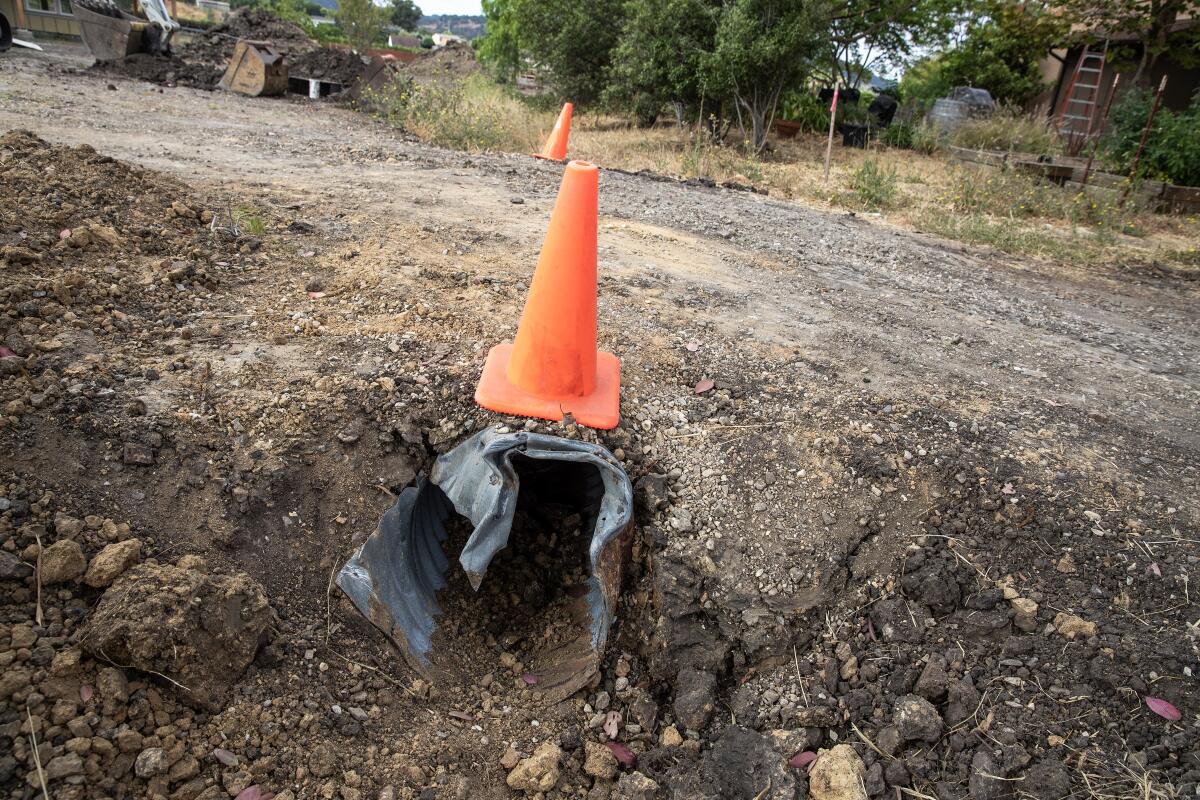
California’s State Water Resources Control Board in 2019 ordered 30 airports statewide to study PFAS contamination of soil and groundwater and found the chemicals around all of those airports at varying levels.
Tests on 74 wells near the San Luis Obispo airport found that 57 contained PFAS at levels exceeding thresholds set by the state.
One of the contaminated wells supplies water for farmland, according to state officials, while 47 are household wells and others serve businesses.
The tests showed wells with levels of PFOS up to 247 times the proposed federal limit. Borland said her well and those of her next-door neighbors have some of the worst contamination.
“We are sky-high levels,” she said.
Under their July 21 agreement with the Regional Water Quality Board, San Luis Obispo County and Cal Fire have pledged to provide water treatment for well owners in phases, starting by installing “point-of-use” filters at kitchen taps for any residents who don’t already have them. The agencies committed to installing “point-of-entry” systems within a year to treat all the water flowing to each home. They estimated the cost of treating the water at $2 million.

The county and Cal Fire also agreed, among other things, to evaluate long-term options, which could include connecting homes to a nearby existing water system, building a new system or installing treatment systems on every contaminated well.
In a written response to questions from The Times, county and Cal Fire officials said they will continue testing water in the area and will “investigate the extent” of PFAS contamination from the airport.
The type of firefighting foam that has been used at airports for decades, called aqueous film-forming foam, was developed by the U.S. Navy in the 1960s for handling jet fuel fires.
The Federal Aviation Administration has long required airports to use the foam containing PFAS, and firefighters have regularly carried out testing, spraying a foam concentrate that is mixed with water at the nozzle. But Cal Fire officials say they changed practices after the FAA in 2019 approved a different type of testing, and now ensure the foam is contained and not released into the environment.
There are also efforts underway to switch to replacement types of foam that don’t contain PFAS.
The EPA is proposing the first federal limits on harmful “forever chemicals” in drinking water, saying it could prevent thousands of illnesses.
The large number of private wells near the San Luis Obispo airport with high levels of PFAS prompted the Central Coast Regional Water Quality Board to prioritize the problem, said Greg Bishop, the board’s senior engineering geologist.

“This agreement takes care of what we know to be the highest impacts to public water supply wells,” Bishop said. “The impacts to supply wells are the highest in the state, around any airports at least.”
Bishop said cleanups will be necessary at other airports in the state, but the contamination problems vary. In Santa Barbara, for example, contaminated groundwater lies beneath the airport but hasn’t tainted wells used for drinking water, he said.
In other cities, homes next to airports receive water from municipal pipes rather than private wells.
In recent studies, researchers have estimated that at least 45% of drinking water across the country may contain one or more PFAS chemicals, and they have found that the contamination may be more prevalent in urban areas of Southern California and Central California than in other regions.
Last month, Los Angeles County supervisors supported a proposal to investigate PFAS levels in drinking water. Supervisor Janice Hahn said it’s critical to pin down where and at what concentrations the chemicals are found so that the county can start developing a plan to get them out of the water.
The chemical manufacturer 3M recently reached a $10.3-billion deal to settle lawsuits over PFAS contamination. But a coalition of state attorneys general including California’s Rob Bonta has opposed the settlement, saying it fails to adequately account for the harm the chemicals have caused.

From her driveway, Borland can see the airport control tower beyond the fence on the other side of the road from her property. She said she thinks her well must have ended up with high levels of PFAS because foam-laden water had a direct route: a culvert under the road that dumps rainwater onto her property.
“We are at a low point, which is why all the water ends up here,” she said, standing next to the pipe. “All the water is washed and it goes right through our property.”
Borland said she and her neighbors have many unanswered questions, including how much of the chemicals they might have in their bodies. She has urged the county health department to provide blood tests for everyone in the area.
California Atty. Gen. Rob Bonta announced that the state has sued the manufacturers of ‘forever chemicals’ such as PFAS, which are linked to cancer.
County officials said they are considering the water board’s recommendation of conducting a health survey.
Long before Borland’s family learned about PFAS, they dealt with other water contamination issues. Disliking the taste of their water, they installed a simple reverse-osmosis filter under the sink. Looking back, she said, they didn’t change the filter often enough, and so it might have gotten plugged up and let the chemicals pass through.
She said she wonders how much of the chemicals they ingested during those years drinking the water.
Several years ago, the Borlands and a group of neighbors learned their water was polluted with trichloroethylene, or TCE, a solvent that was traced to a nearby business. Through a legal settlement, several homeowners were given carbon filters, which removes TCE and PFAS from tap water inside the home.
For the past several years, Borland and her husband have been drinking bottled water. But water from the well still flows directly to their garden, where tomatoes are ripening on the vines.
“The big problem is, we’re continuing to pollute all our property, because all the irrigation water is full of PFAS,” she said. “So we need the carbon filter moved to our wellhead. That’s what all of us need.”
